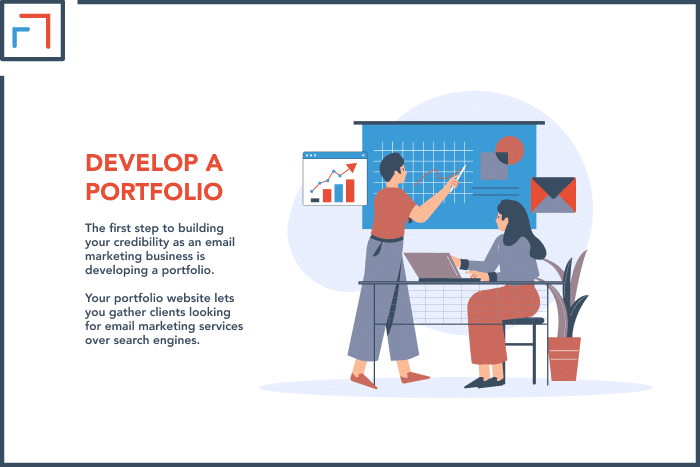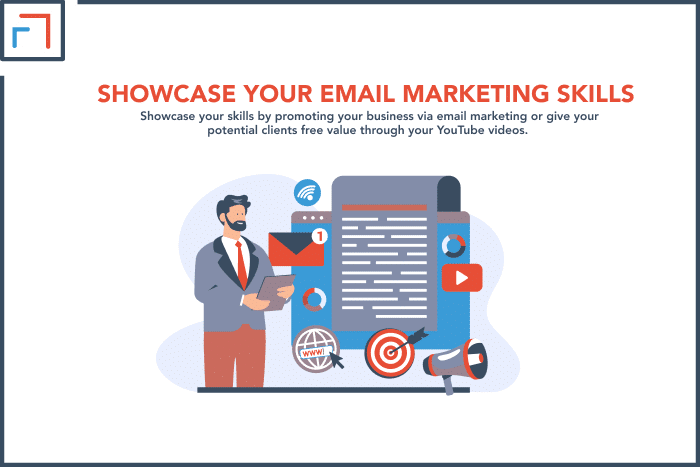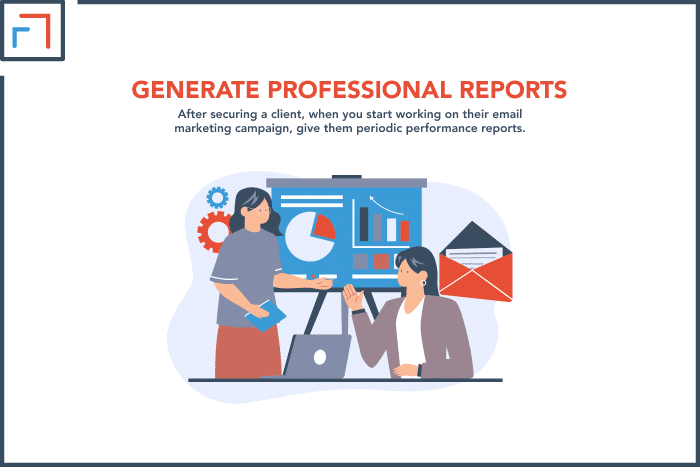Starting a business is no easy feat. And when your business is about driving results for other businesses, it becomes even harder. As an email marketer, you know your services would directly impact a company’s ROI. But how do you convince clients what you can do for them as a new business?
To start an email marketing business, create a professional portfolio. Initially, offer free or discounted services to build case studies. Engage potential clients with valuable content, assess their needs before pitching, and provide performance reports to foster long-term relationships.
In this article, we will lay a roadmap that you can follow to lay the foundation of your email marketing business, build a reputation, and gather clients.
Steps to Start an Email Marketing Business
A lot of groundwork is needed before designing email campaigns for your clients. The first step in starting a business is to develop its virtual presence.
There are several other steps after this. You can’t expect clients to start pouring in just after establishing a social media presence or announcing that you’re offering email marketing services.
Just like any other business, it is essential first to build credibility.
The first few steps listed below will focus on how you can build your credibility before getting to the part where you can start providing your services to business clients:
1. Develop a Portfolio
The first step to building your credibility as an email marketing business is developing a portfolio.
71% of employers state that the portfolio’s quality is a vital factor when hiring.
There are several ways to present portfolios. However, portfolio websites are the most professional-looking.
After all, if you want clients to enter into business with you, you will want to showcase your skills and professionalism.
Plus, your portfolio website lets you gather clients looking for email marketing services over search engines.

Pro Tip: What to Add in an Email Marketing Portfolio? Your portfolio might include sample email templates, copywriting examples, design layouts, and detailed performance metrics of past campaigns, like open rates and conversion rates.
You can also add client logos and websites to each case study in your portfolio for increased authenticity.
No content for a portfolio? If you don’t have much to add to your portfolio, you can start gathering case studies by offering free services to small businesses on Facebook or Instagram.
Many businesses on Facebook or Instagram market exclusively on social media.
By helping these clients establish email as a channel of communication with existing clients for a limited time, you can gather projects to add to your portfolio.
Once they get results from the email marketing campaign, they might be willing to pay you for your services after the free trial!
2. Set Up a Social Media Presence
Having a search engine-optimized portfolio website can help you reach businesses organically. But it’s best not to put all your eggs in one basket.
You can set up a social media presence to showcase your portfolio to a targeted audience.
While selecting the social media platform for your digital presence, consider where to reach your potential clients.
For example, LinkedIn is one of the best platforms for businesses marketing their services to other businesses (B2B business).
Aim to post insightful content at least twice a week. Share your recent work, industry updates, tips, and best practices for email marketing to establish your authority and keep your audience engaged.
Let’s look at some stats to get an idea of how powerful this strategy is: 89% of B2B marketers rely on LinkedIn for lead generation.
(Source) LinkedIn yields a 28% lower cost per lead than Google AdWords.
(Source) 92% of B2B marketers use LinkedIn to establish authority through content marketing or thought leadership articles.
(Source) 39% of decision-makers in a business extend individuals/businesses the opportunity of a request for proposal (RFP) process after going through their thought leadership content on LinkedIn (Source).
These stats show how important thought leadership content is to secure clients. But to establish credibility, don’t just pick one avenue for posting content.
Our next step talks about the content you need to showcase your email marketing skills and secure your first few clients.
You can get some great content ideas in my article on what to put in marketing emails.
3. Showcase your Email Marketing Skills
Thought leadership content is highly valued on LinkedIn. You can post it as a business or an entrepreneur for personal branding.
But getting noticed on a platform like LinkedIn requires a lot of time and work.
While you post on LinkedIn for a chance to get noticed by established companies, you should explore more avenues to get your business started.
For instance, as an email marketer, you can showcase your copywriting skills by promoting your business via email marketing. Or you can give your potential clients free value through your YouTube videos.
But how will you gather emails when spamming isn’t an option?
Remember the pro tip discussed earlier about offering free services to small businesses? Once they see value in your services, ask them if they want to join your email list.
Next, you can connect with marketing executives working in SMEs over LinkedIn and ask them if they want to read up on email marketing or get free resources.
From there, you can build your email list to build your sales funnel. For an in-depth tutorial, do read my article on how to build a sales funnel from scratch.

4. Assess your Clients
If you can offer your proposal to a client after following the above three steps, don’t rush to send them a generic pitch deck. Take your time to ask questions or study the client and then make your offer.
Here is a list of questions you can ask your clients to assess their needs before showing them related case studies from your portfolio or pitching to them with an offer:
- Are you currently using email marketing? If yes, how successful has it been for you?
- What content resonates most with your audience (e.g., educational articles, product promotions, storytelling)?
- Do you have existing content that can be repurposed for email campaigns?
- Do you want to convey any specific messages or brand values through email marketing?
- How do you measure the success of your email campaigns (e.g., click-through rates, conversion rates)?
- What internal resources (designers, writers, developers) are available to support email campaign creation?
- Do you have any examples of successful email marketing campaigns from competitors or similar businesses that you admire?
5. Generate Professional Reports
After you’ve secured a client and started working on their email marketing campaign, give them periodic performance reports rather than just sharing results verbally.
Even if you’re working with a small business, giving them a professional report or presentation on the campaign performance only showcases your professionalism and dedication to improve.
In the reports include key metrics like open rates, click-through rates, conversion rates, bounce rates, and unsubscribe rates.
Explain how these metrics correlate with your client’s business goals and recommend future strategies based on these data points.
As a result, they might even dedicate a higher budget for email marketing or refer you to other clients if they’re impressed with the performance.

Final Words
Starting a business is hard work, let alone a business that helps other businesses get clients.
To prove to your clients that you have the skills and the professionalism to help them get clients through email marketing, start by developing a portfolio and a social media presence.
Once you’re done with these basics, it’s time to showcase your email marketing skills by establishing a brand with authority.
That brand could be you, the entrepreneur, or your company. When you secure clients, assess their needs, and deliver more than they expect to establish a long-term, profitable relationship.
